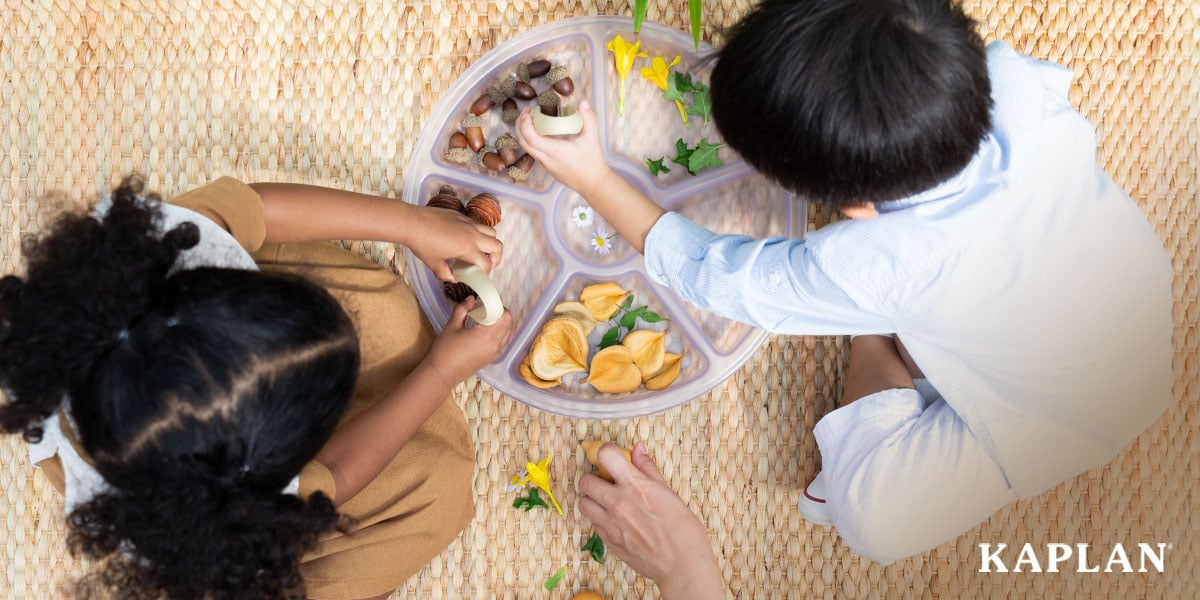This scenario is just one of many examples of loose parts play in an early childhood classroom.
Although this is not a new concept, there are many misconceptions and worries surrounding play that involves loose, open-ended materials. For starters, how do you contain the mess of loose materials so that your classroom remains safe for young children? How do materials like acorns and sticks support a child’s education? Finally, are there any practical benefits to this type of play?
This article will ease these worries by introducing you to the concept of loose parts play and how it enriches learning in early childhood.

What is loose parts play?
According to early childhood and loose parts play experts Miriam Beloglovsky and Carla Gull, loose parts is defined as “open-ended, interactive, natural, and manufactured materials that you can manipulate with limitless possibilities.” As children play with these materials, they can think, build, explore, and become architects of their own learning. There is no “right way” or “wrong way” to play with loose parts, and using these materials supports the development of fundamental skills such as decision-making, creativity, problem-solving, adaptability, and motivation.
Educators can provide any child-safe and age-appropriate items during loose parts play. Some common loose parts items you might find in an early childhood classroom include:
- Nuts, bolts, and screws
- Small wooden shapes or discs
- Faux gemstones
- Natural materials such as leaves, acorns, shells, or pinecones
- Flower petals and leaves
- Sanitized sticks and animal bones
You can find loose parts by going on a scavenger hunt outdoors or browsing the scrap bin at a local thrift store. Kaplan also offers a variety of loose parts kits featuring natural materials, colorful discs, nuts and bolts, and more.
How does loose parts play enrich child learning?
Some educators believe that loose parts play lacks structure and does not support learning outcomes for young children. However, there are many ways that loose parts materials and their use can support a child’s growth and development. No matter the scope of your classroom curriculum, loose parts can support teacher-led activities and daily lessons and help children comprehend fundamental information they see and hear.
Loose parts play is not exclusive to a classroom STEM learning center. You can incorporate these materials into your dramatic play center, block center, and classroom and outdoor learning spaces.

What are the practical benefits of loose parts for early childhood educators?
Using loose parts in the classroom gives educators flexibility in their teaching and expands the learning that happens for young children. Educators can incorporate materials that ignite children’s interests and accompany weekly themes and lessons. Loose parts play also supports exploration, experimentation, and inquiry-based learning.
One aspect of loose parts play you may not know is that these materials naturally promote inclusivity. Open-ended materials do not come with set instructions, easily accommodating diverse learners and their unique patterns of play.

Common misconceptions surrounding loose parts play.
One reservation many educators have about incorporating loose parts in their classrooms is that they worry the materials will be messy. Anything in a room full of young children can eventually turn messy. Baskets and loose parts trays will help keep your items contained and organized when using loose parts for classroom activities. They also provide vessels where children can sort their play materials during clean-up time, enhancing the way they care for the environment.
Another misconception about loose parts play is that the materials are unsafe for use around young children. Of course, you want to be mindful of any items that could pose a choking or safety hazard for young children and remove those items from your loose parts assortment. However, if you keep a watchful eye on children engaging in loose parts play, it offers a safe way for children to explore and learn.
How can you integrate loose parts play in your early childhood classroom?
As you can see, loose parts play is an effective source of learning, growth, and development for young children. Incorporating loose parts into your classroom and daily lessons may require a certain amount of buy-in from administrators and parents/family members alike. You may also need to be more familiar with this concept yourself before you feel confident enough to incorporate open-ended materials in your classroom learning centers.
Download the Loose Parts Mindset PDF, crafted by esteemed researcher and author Carla Gull, EdD, to learn to embrace loose-parts play, encourage child exploration, and incorporate open-ended materials in your classroom.


